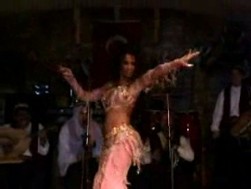|
Öykü Potuoğlu-Cook
Situating Belly Dancers and Musicians The recent global interest in belly dance has undoubtedly spurred not only popular enthrallment, but also academic inquiry that examines dance vocabulary, shifting social relations, and vectors of exoticism in multiple contexts (Shay and Sellers-Young 2003; Nieuwkerk 1995; Arvizu 2004; Shay 1999; Lorius 1996). Although still underresearched, Turkish belly dance’s emergent ubiquity generates fresh avenues of inquiry. In particular, the glitzy comeback of belly dance in Istanbul is tied with simultaneous processes of Orientalist heritage tourism and urban restructuring. In the post-1980s era of liberalization, secular and Islamist governments, in conjunction with foreign and local private investment, have cultivated a West-facing Orientalized city glistening with global city apparatus (Keyder 1999; Robins and Aksoy 1995) and marketable Ottoman neighborhoods (Çelik 1994; Ergün 2004) and performance practices. Belly dance and its practitioners have served as dubious bearers and agents of Orientalist fantasy and spectacle, in particular, and of national economic and moral ambitions, in general. In globalizing Istanbul, belly dancers and musicians, Rom and non-Rom alike, are trapped between Islamist and secular moral designs as well as continued ethnic marginalization and/or glorification: they are simultaneously lauded and degraded [1].
In this paper, I cast an ethnographic eye on the inner workings of Istanbul entertainment in order to reveal equivocal tensions rooted in gender, ethnicity, and class distinctions among performers, dancers and musicians alike. Taking my cue from combined emphasis on gender, class, and ethnicity in recent ethnomusicology scholarship (Magrini 2003; Sugarman 2003; Silverman 2003) and belly dance research (Nieuwkerk 1995), I underscore the fluidity between performance and everyday strategies; between aesthetic choices and economic priorities; and between moral distinctions and ethnic affiliations. [2] Treating sweat, power, and art as interlocking spheres of Turkish belly dance production, I expose how multiple vectors of vulnerability intersect in belly dancers and musicians’ lives as they interact with each other, agents, bosses, and tourist audiences in and beyond the performance space. As well, this strategy allows me to configure kinetic and aural cues as integral to shifting processes of social, ethnic, and sexual differentiation in contemporary Istanbul’s entertainment-scape and elsewhere.
|
